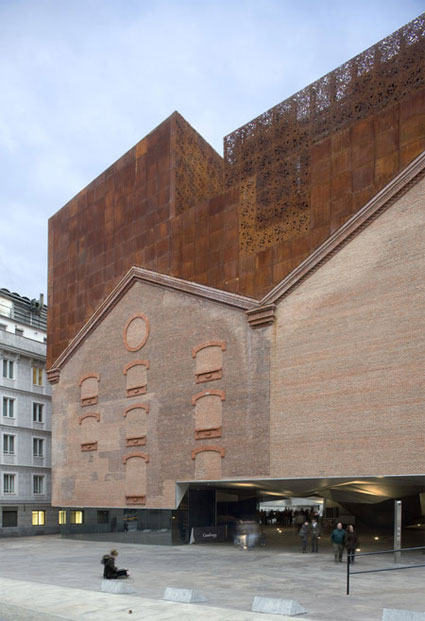Scanning through my RSS feeds this afternoon, I came across Regine Debatty’s 6/30/08 blog post, Interactivos? workshop: Augment(o)scope, which included a photo of Madrid’s CaixaForum, as redone by Herzog & de Meuron.

I had come across the image months ago, but today it clicked with the problem of the Janion Hotel (or Janion Building), an old (heritage) building in downtown Victoria.
What if, I thought, we had the resources to do something like this with the Janion?
As it stands, the building underutilizes its site. It’s only 3 stories tall and sited on its parcel in such a way as to make additions tricky.
What Herzog & de Meuron did with Madrid’s former converted 1899 power station, “one of the city’s few remaining examples of historically significant industrial architecture,” is an inspiration. The ground floor was practically dug out — and in the case of the Janion, a significantly smaller building, I’m thinking lift the building up an entire floor to create a similar ground floor space. An expanded basement, plus a deliberately modern (yet somehow traditional-looking) addition, give the new hybrid structure in Madrid the square footage it needs to be a useful participant in a modern city’s economy.
Of course it is a total pipe dream — a midsummer night’s dream — to think that something like this could happen for Victoria’s Janion Building, because there isn’t anyone here with pockets deep enough to pay for such a project.
But just imagine…
For more words (and some pictures) on the Janion, see Robert Randall’s blog entries here. For pictures, see flickreeno Professional Recreationalist’s set here (really click through to his photos, which are powerful, and quirkily staged — he uses plastic dolls and photographs them against their backdrops to make them appear life-sized).
Here’s one of his photos, showing the Janion’s north-west (back) sides:

If you’re thinking, “what a hunk of junk,” take a look at the front of the building, which is a bit more interesting, as seen on Triviaqueen’s blog, and a great front facade detail on one-eyed man’s site.
The reason I find this particular photo of the Janion by Professional Recreationalist of interest is because it shows the drop in grade, from the front of the building to its back. Removed, as in Madrid’s CaixaForum, that fieldstone foundation would open up a grand, useful space, especially if that removal included lifting the building up a few feet.
The grade changes here are not dissimilar to CaixaForum’s grade changes, which Herzog & de Meuron exploited to create an open, airy ground floor.
Here’s a photo of the Madrid building before Herzog & de Meuron transformed it — it was as similarly deficient in allure as the Janion now appears to be:

Note the stolid foundation/ basement stones, now entirely removed.
For an idea of what you might be able to create in a newly “lightened” ground floor, see this photo of CaixaForum’s cafeteria:

The addition built on top of CaixaForum is daring — it would probably freak people here out. But it gave the building the additional space it needed, and a completely new lease on life.
{ 3 comments }
I find this approach intriguing, but would be more comfortable seeing it used on buildings that have some charm but are utterly beyond redemption and have little remaining aesthetic or historic value.
Keep in mind Victoria went through a phase 30 years ago when architects tried to make old buildings relevant by turning them inside out, in some cases removing roofs and facades and bringing landscaping indoors. Examples include buildings on the west side of Fort near Yates and one on the west side of Douglas between the Aveda salon and the big dollar store.
On second thought, the Janion could be a good candidate due to the slope you mentioned and is so evocatively captured in that photograph.
Currently, most armchair architects favour either retaining only the Store St. facade or keeping the building in its entirety. Excavating the lower floors and creating an airy, glassy atrium would be the best method of retaining the building.
Even if the building were retained, the concrete extension seen clearly in Recreationalist’s photo must be removed. A glassed-in elevator like the one behind the Wax Museum would fit well.
Rob, which buildings do you mean in your first comment? (“Examples include buildings on the west side of Fort near Yates and one on the west side of Douglas between the Aveda salon and the big dollar store.”) Is the one on Douglas the building with Mint in the basement? Or the one right next to Aveda? I think the one right next to Aveda is grey granite and attractive, iirc, but the one with Mint in it is really crap-looking, very dark & uninviting, sort of like saying, “f-off and stay out.”
.
.
I can’t picture which you mean on Fort, especially since Fort has a north & south side, and runs parallel to Yates. So I’m guessing you mistyped what you meant?
.
.
As for the Janion, I think you’re right wrt a glassed in elevator — that would look great. But the building is still tiny, relative to the amount of land that’s there, and not only is it tiny, but it’s sitting on that land in such a way that you can’t really do anything with it except add on …and on and on.
.
.
It’s tricky. Basically, the thing could (should?) be preserved for its facade, but then you have people who say the interior is still pristine and should be preserved too, and then you’re back to the problem of having a pretty small building underutilizing a valuable piece of downtown harbour-front land…
Comments on this entry are closed.